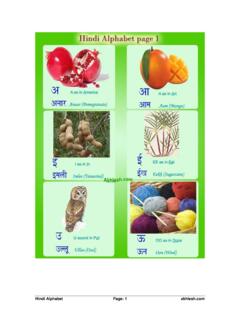Transcription of Essential Tagalog Grammar
1 Essential Tagalog Grammar Second Edition A Reference for Learners of Tagalog Fiona De Vos Copyright 2011 Fiona De Vos All rights reserved. Second Edition ISBN 978-90-815135-4-8 (small paperback) ISBN 978-90-815135-8-6 ( Grammar + 3 course books) Also available in other formats: ISBN 978-90-815135-1-7 (large hardcover) ISBN 978-90-815135-2-4 (large paperback) ISBN 978-90-815135-3-1 (ebook) D/2011/Fiona De Vos, uitgever NUR 630 Cover painting by Sabrina dei Nobili. To my husband, Fre 5 Contents Introduction 13 Pronunciation 17 Vowels and consonants 17 Long vowels (stress) and glottal stops 21 Replaceable sounds 25 Forming and connecting words 29 Roots and affixes 29 Sound changes when combining roots and affixes 31 Syllable repetition 33 Na/-ng 34 Basic word order 35 The POD and the News 35 The POD 35 The News 36 The Tagalog POD and the English subject 38 Markers 43 Ang markers 43 Uses of Ang markers 45 Ng markers 45 Common uses of Ng markers 46 Sa markers 49 Common uses of Sa markers 49 Summary 51 6 Essential Tagalog Grammar Pronouns
2 53 Ang pronouns 53 Personal pronouns 53 Demonstrative pronouns 55 Uses of Ang pronouns 57 Ng pronouns 58 Personal pronouns 58 Demonstrative pronouns 59 Common uses of Ng pronouns 61 Sa pronouns 63 Personal pronouns 63 Demonstrative pronouns 64 Common uses of Sa pronouns 66 Summary: markers and pronouns 68 Kita 71 Kami ni John etc. 72 Mismo 74 Nouns 77 Gender 77 Plurals 78 Noun affixes 80 Compound nouns 99 Verbs, adjectives etc.
3 Used as nouns 101 Verbs used as nouns and their objects 102 Verbs 105 The basic form 105 Roles of the POD 105 Verb affixes 108 Aspects 206 Overview 206 Completed 208 Uncompleted 210 Unstarted 212 Contents 7 Summary 214 Recently completed 215 Intensive recently completed 217 Irregular verbs 218 Commands, requests and wishes 220 Commands 220 Requests 221 Let s eat, go etc.
4 222 I wish, I hope etc. 223 Huwag 225 Repeated verbs and verb roots 227 Verbs expressing mental states or perception 228 Basic forms used as nouns 230 Adjective + basic form 230 Non-basic-form verb + basic form 232 Maging 234 Roots used as verbs 234 Pseudo-verbs 236 Overview 236 Using pseudo-verbs 237 Repeated pseudo-verbs 240 Adjectives
5 241 Identical adjectives and nouns 241 Gender 242 Affixed and unaffixed adjectives 242 Adjective affixes 243 Compound adjectives 257 Intensity 258 Intensifiers and downtoners 258 Repeated adjectives 260 Repeated non-adjective roots 260 Adjectives with syllable repetition 261 Plural adjectives 262 Comparing persons or things 263 8 Essential Tagalog Grammar Equality 263 Inequality 266 Superlative 267 Other describing words 269 Expressing quantity or distribution 269 Cardinal numbers 269 Spanish-derived cardinal numbers 272 Ordinal numbers 273 Fractions 273 Other number expressions 274 Numbers in use 278 Other words expressing quantity or distribution 280 Expressing similarity 284 Gaya, ganito.
6 Ganito ka- 284 Para 286 Tulad 287 Mukha 287 Expressing manner 288 Expressing location 289 Nasa 289 Nandito, nandiyan, nandoon 291 Sa 292 Dito, diyan, doon 292 Eto, ayan, ayun 293 Wala sa, wala rito 294 May 295 Positions 296 Expressing source or destination 298 Expressing extent 299 Expressing time, frequency or duration 300 Month names 300 Days of the week 301 Parts of the day 301 Clock time 302 Contents 9 General time expressions 304 Time expressions with an introducing word 306 Combining time expressions 310 Time clauses 311 Expressing condition 318 Expressing cause.
7 Result or purpose 322 Expressing contrast 326 Expressing possibility 328 Expressing other relationships 333 Enclitic words 339 Overview 339 Using enclitic words 340 Enclitic words and na/-ng 340 Order of enclitic words 341 Enclitic words in clauses or Ang/Ng/Sa phrases 342 Exceptions to the follow-the-first-word rule 342 Meanings of enclitic particles 345 Na 345 Pa 353 Man 357 Nga 358 Din/Rin 361 Lang 362 Naman 365 Daw/Raw 368 Po /Ho 369 Ba 369
8 Pala 370 Kaya 372 Muna 373 Tuloy 374 Kasi 375 Yata 376 Sana 377 10 Essential Tagalog Grammar May, mayroon/meron, marami, wala 379 Overview 379 Stand-alone meron/marami/wala 381 Meron/marami/wala + nito etc.
9 382 May/meron/marami/wala + verb/adjective/etc. used as a noun 383 May/meron/marami/wala + noun + verb 385 Walang ka- +rep2 386 Questions 387 Yes/no questions 387 Confirmation questions 389 Alternative questions 391 Please-repeat questions 392 Questions using question words 393 Overview of question words 393 Using question words 394 Other sentence structures 407 Negation 407 Hindi 407 Ewan 409 Ni
10 410 ni 411 Other 411 Kahit (na) ano etc. 412 At, o, pero etc. 414 Buti at, salamat at etc. 417 Indirect speech or thought 418 Introduced by na/-ng or kung 418 Not introduced by na/-ng or kung 419 Sentences with no POD 421 POD-first sentences 424 POD ay News 424 POD pause News 425 Additional notes on word order 425 Contents 11 Greetings and other social expressions 427 Other useful sentences 431 Opening particles 432 Closing particles 435 Interjections 438 Appendix A: Spelling system using diacritical marks 441 Appendix B.




